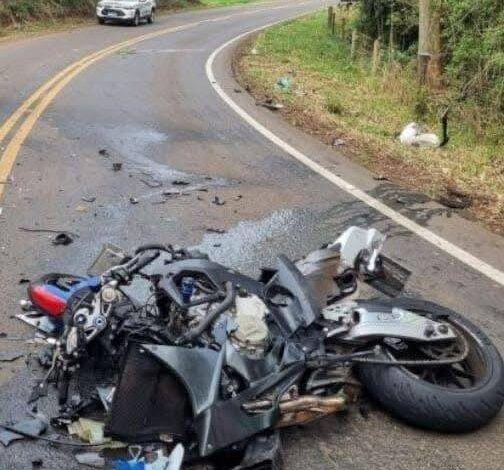Much pain and sadness, Dies in a very serious accident the dear pi! see more in comment

A tragic accident on the SC-390 highway has left the community of Ipira, in the Midwest region of Santa Catarina, grieving and searching for answers. What should have been an ordinary Saturday afternoon turned into a devastating scene when a 31-year-old motorcyclist lost his life in a violent head-on collision. The crash happened on November 7, along a winding stretch of road known for sharp curves and limited visibility — factors that make precision and caution essential for anyone traveling through the area.
According to early reports from the Military Highway Police (PMRv), the victim had been riding a high-performance BMW S1000 RR, a model admired by enthusiasts for its power, speed, and aggressive handling. It’s a bike built for performance, but that performance demands absolute focus, especially on a road like SC-390. Investigators say that during one of the curves, the motorcyclist crossed into the opposite lane, directly into the path of an oncoming vehicle. That vehicle, a Renault Sandero driven by a 30-year-old woman, had no time or space to avoid impact.
The collision was head-on — the kind of crash that instantly turns deadly. Even with full protective gear, a motorcyclist is incredibly vulnerable when facing the mass and force of a car traveling toward them. Responders who arrived at the scene described the damage to both vehicles as extensive, with debris spread across the pavement. Efforts to save the motorcyclist were unsuccessful. He died at the scene, his injuries far too severe.
The woman driving the Sandero reportedly survived, but the emotional toll is undeniable. Accidents like this don’t just affect one family; they leave ripples through an entire community. Witnesses, residents, first responders, and even other drivers who passed through afterward all grappled with the harsh reminder of how fragile safety becomes when a single mistake meets the wrong moment.
The PMRv’s preliminary analysis indicates that lane invasion during the curve was the primary cause. Whether it was excessive speed, misjudgment, distraction, or simply the bike drifting wide due to the nature of the turn may take additional investigation to determine. Roads like SC-390 demand a specific rhythm — riders need to enter curves with control, pick a line, and maintain balance. A small miscalculation can quickly become irreversible. For cars, these curves are manageable but require attention. For motorcycles, especially powerful ones, the margin for error shrinks dramatically.
Residents of the region have raised concerns before about the dangers along the SC-390. Its stunning scenery attracts riders, but the combination of tight curves, elevation changes, and occasional uneven pavement has led to a number of severe accidents over the years. Locals know the road’s temperament well; newcomers and thrill-seeking riders may underestimate it. This crash has renewed discussions about whether additional road signage, speed warnings, or structural improvements could reduce the risks.
But beyond the technical analysis of how the accident happened, the human impact is what lingers. A 31-year-old man left home that day expecting a normal ride. Families on both sides of the collision are now facing pain that will stretch far past the moment of impact. The victim’s loved ones are grieving the sudden loss, trying to understand how an ordinary afternoon turned into tragedy. The driver of the car, although physically safe, now carries the emotional burden of an event she could not control. First responders, who see more tragedy in one month than most people witness in a lifetime, face yet another difficult memory to add to the list.
Motorcycle accidents, particularly involving high-performance bikes, often highlight the delicate balance between passion and risk. Enthusiasts ride because they love the freedom, the control, the sensation of the road beneath them. But the same qualities that make riding exhilarating also make it unforgiving. It only takes one miscalculation — a corner taken too wide, a moment of overconfidence, a hesitation — for everything to fall apart. Every rider knows this. Every family of a rider fears it.
In the aftermath of the crash, authorities urged drivers and motorcyclists alike to take extra caution when navigating the SC-390 and similar routes across the region. Curves that seem harmless at lower speeds become traps at higher ones. And even safe drivers can become victims when someone else loses control.
Communities around Ipira often come together quickly after tragedies like this. Messages of support and condolence spread through social media. Some express heartbreak; others share their own stories of close calls or lost friends. Many hope that more awareness might prevent future accidents. When a life is cut short, people instinctively search for meaning, for lessons, for ways to make sure it never happens again.
This tragedy also ignites conversations about traffic safety more broadly. Brazil has long fought to reduce fatal accidents, especially those involving motorcycles. Training programs, regulations, and awareness campaigns continue to evolve, but real-world change is slow. Roads vary, conditions shift, and motorcycles — despite technological improvements — remain exposed in ways no metal frame can fully protect.
As the investigation continues, the official report will eventually detail the technical causes behind the collision. But the emotional truth is already clear. A young man is gone. A driver’s life is altered. Families are hurting. Communities are shaken. And a moment of misjudgment on a curve has left devastation that can’t be reversed.
For now, all that remains is reflection — the reminder that every road demands respect, every curve calls for caution, and every ride is a responsibility shared with everyone else using the same strip of asphalt. The hope is that by telling these stories with honesty, others will take them to heart, slow down, stay alert, and reach their destinations safely.